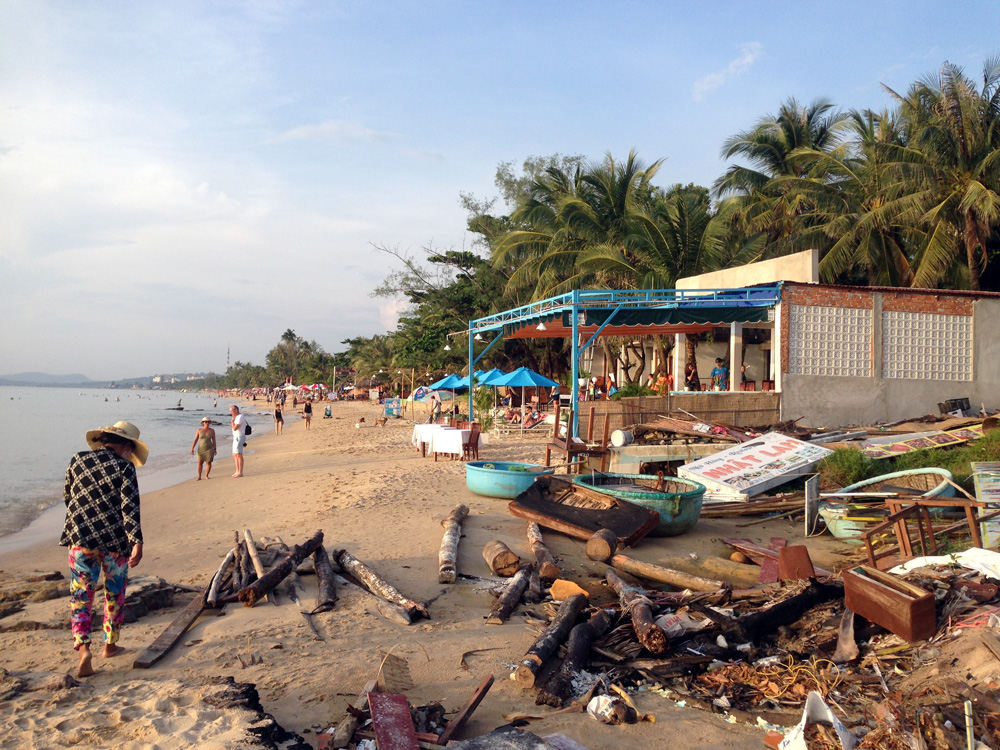It is a comparatively small geographical area from which most of the plastic reaches the seas and oceans. It comprises the five fast-growing economies of China, Indonesia, the Philippines, Thailand and Vietnam. In this region, the use of plastic items and packaging is hardly questioned. There is a lack of awareness of more environmentally friendly everyday practices, but above all there is a lack of adequate disposal or recycling options. This also applies to Vietnam’s largest island, Phu Quoc. ISOE researcher Heide Kerber chose the island on the west coast of the Mekong Delta for field studies in the PlastX research project because all facets of the “plastic flood” can be seen here.
On the island of Phu Quoc, which is very popular with tourists, waste production of around 160 tons per day already exceeds the capacities available for disposal. There is no comprehensive collection system and there are no secure landfills. “The extent of pollution of the landscape, beaches, sea, rivers, open spaces and roads on Phu Quoc, especially from household waste, is overwhelming,” says Heide Kerber. “The waste masses not only have a massive impact on the environment, but also on the quality of life of residents, both in terms of health and economy. Many locals depend on the income from tourism, but the ‘plastic flood’ is already having a negative impact on the island's attractiveness.”
“The daily amount of waste on Phu Quoc has tripled since 2005,” reports the environmental scientist, “the waste infrastructure cannot keep up so quickly”. The island with its 110,000 inhabitants is particularly affected by the rapidly growing mass tourism. This is why the first hotel and resort operators have now become active themselves. “You see more and more beach cleaners picking up garbage on tourist beaches to keep it away from bathers. But of course this is pure aesthetics, it doesn’t solve the causes of the garbage problem.”
Island Phu Quoc as case study for plastic waste problem of the whole region
ISOE researcher Heide Kerber has chosen the island of Phu Quoc as a case study region to gain a deeper understanding of the causes of high plastic waste, problem perception and possible solutions. And also to better understand the practices of different actors with regard to the consumption and disposal of plastics and plastic waste: How is the problem perceived and how is the problem awareness, especially among local authorities? How can tourists and the tourism branch as a whole be made aware of the problem, which – with two million visits a year – is a major contributor to the high volume of plastic waste? With her case study, Heide Kerber also lays the foundations for the development of appropriate communication strategies and awareness-raising campaigns to promote the prevention of plastic waste: The results of her case study will be taken up by the project “Phu Quoc – Towards a Plastic Waste Free Island in Vietnam” of the cooperation partner WWF.
“The plastic waste problem can only be solved if many different measures are interlinked”, says Heide Kerber. “Phu Quoc urgently needs a set of solutions that includes technical components, recommendations for governance, i.e. political-administrative strategies, and awareness-raising measures that focus on consumers.” Kerber evaluates the fact that the topic has now been integrated in the school curricula and that the first initiatives have been launched as important first steps.
Heide Kerber writes about her field research on Puh Qhoc at the PlastX-projects website. The WWF has published an interview on this subject: https://www.wwf.de/plastikflut/phu-quoc-interview-heide-kerber/
About PlastX
The PlastX junior research group, led by ISOE, is investigating the social role of plastics and the associated environmental impacts. The team of social and natural scientists is working on how to make plastics more sustainable. The junior research group “PlastX – Plastics as systemic risk for social-ecological supply systems” is supported by the Federal Ministry of Education and Research (BMBF) in the programme “Research for sustainable developments (FONA)”. PlastX is part of the funding measure “SÖF – Socio-Ecological Research” in the funding area “Junior Research Groups in Social-Ecological Research”.
